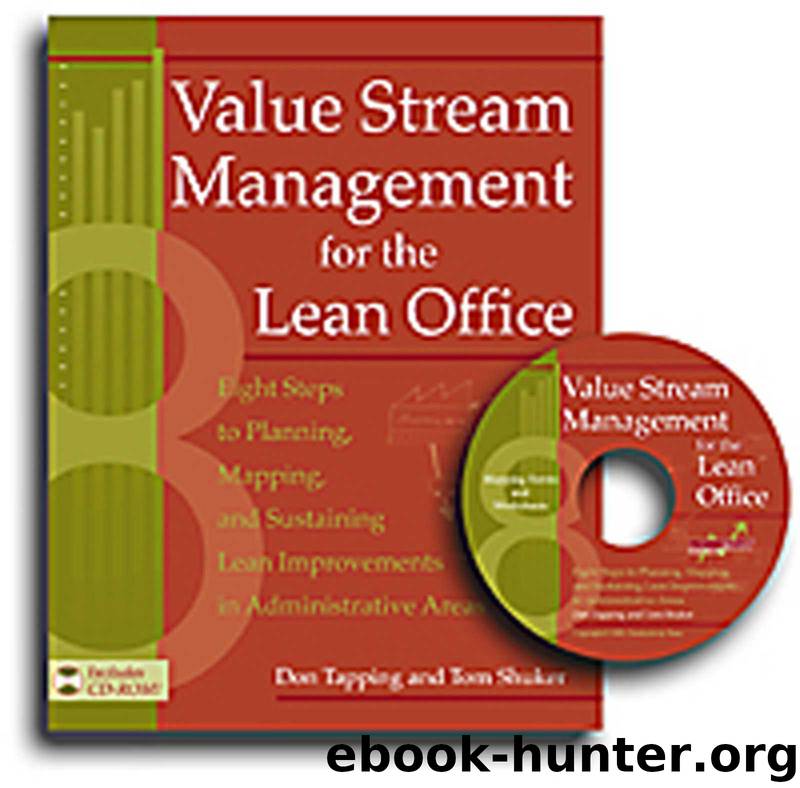Value Stream Management for the Lean Office: Eight Steps to Planning, Mapping, & Sustaining Lean Improvements in Administrative Areas by Don Tapping & Tom Shuker

Author:Don Tapping & Tom Shuker
Language: eng
Format: mobi
Publisher: CRC Press
Published: 2003-02-19T14:00:00+00:00
Joe
Debbie
CSRI-Susan /
CSRII-John /
CSRI-Susan /
CSRII-John /
Debbie
Joe
Cathi
Jane
Cathi
Jane
Sort orders
Sort by
Sort /30s
Post Orders/30s
to Dept/5s
Customer/5s
Initiate Order/
Check P
art
Assign Deliver
y
Review /15s
45s per line
#/10s per line
Date /30s/ per line
per line
Place in
Date
Out Box/5s
Stamp/2s
Returned
Attach Revisions
File Hard Copy/ 90s
Work/4m
/10s per line
1.5m/order
Place in
Folders for
Expedite
Assign Part #/
CSR/10s
Order/10m
15s per line
Est. Price/60s
per line
480
240
240
120
60
240
240
480
.16
.28
11.25
23.75
.9
3.75
.5
.5
TLT = 2149.19 m or 4.5 days
TCT = 49.19 m
VA% = 2.3%
5
Metrics
8
7
Lead Time Total CycleTime
On-time Delivery
DPPM
Assessment
Base
Proposed
Base
Proposed
Base
Proposed
Base
Proposed
Base
Proposed
Base
Proposed
4.5 days
49.19
32%
4,691
14
min
Figure 42. Current-State Map with Step Charts
This page intentionally left blank
Lean Office Step 6-I.M1 11/21/05 10:36 AM Page 83
Step 6–Phase I. Map the Future State—
Customer Demand
At this point the core implementation team has mapped the current state, performed a lean office assessment, and chosen lean measurables for the value stream. They have learned how to see and think lean. Now it is time to tap the creativity of the workforce and the core implementation team to design the future state. An understanding of how lean applies to administrative value streams is never more crucial than in Step 6. Mapping the future state of a value stream involves identifying all the administrative lean tools—such as FIFO lanes, work-area design, supermarkets, and 5S—that will help ensure you can meet customer requirements, establish a continuous workflow, and distribute work evenly. Your future-state map will actually show where these tools are to be used.
The process for mapping the future state takes place in three phases: 1. Customer demand phase. Understand the customer demand for your services and work units, including quality characteristics and lead time.
2. Continuous flow phase. Implement continuous flow so that internal and external customers receive the right work unit, at the right time, in the right quantity.
3. Leveling phase. Distribute work evenly, by volume and variety, to reduce queue times and allow smaller work units to move, if practical.
In this first section of Step 6 we will be focusing on the customer demand phase of the future state. We will describe the techniques associated with determining customer demand, the tools that can be used to meet it, and the process for mapping.
Phase I: Customer Demand
How often have you heard the statement “The customer is number one,” but seen very little done to actually ensure customer satisfaction? By focusing on customer demand first you will do something about this. Your efforts in this phase will apply specific measures and techniques to ensure consistent fulfillment of customer requirements. You will: 1. Determine takt time.
2. Establish pitch.
3. Determine how to meet demand through:
a. Buffer and safety resources
b. 5S for the office
c. Problem-solving methods
83
Lean Office Step 6-I.M1 11/21/05 10:36 AM Page 84
84
Step 6–Phase I. Map the Future State—Customer Demand
Questions for Focus on Demand
Application of the demand phase can be summarized by the following questions:
• What is the demand? In other words, what is the takt time?
• Are you overproducing, underproducing, or meeting demand?
• Can you meet takt time (or pitch) with current administrative capabilities?
• Do you need administrative buffer resources? Where?
• Do you need administrative safety resources? Where?
• What problems need to be solved right now?
• Where does your office need organization, ordering, and cleaning?
To what degree?
Determine Takt Time
From the data you collect on customer demand, you will determine takt time.
Download
This site does not store any files on its server. We only index and link to content provided by other sites. Please contact the content providers to delete copyright contents if any and email us, we'll remove relevant links or contents immediately.
Bad Blood by John Carreyrou(6265)
Rich Dad Poor Dad by Robert T. Kiyosaki(6162)
Principles: Life and Work by Ray Dalio(5933)
Playing to Win_ How Strategy Really Works by A.G. Lafley & Roger L. Martin(5434)
Management Strategies for the Cloud Revolution: How Cloud Computing Is Transforming Business and Why You Can't Afford to Be Left Behind by Charles Babcock(4435)
The Confidence Code by Katty Kay(4027)
Thinking in Bets by Annie Duke(3989)
American Kingpin by Nick Bilton(3495)
Delivering Happiness by Tony Hsieh(3273)
Project Animal Farm: An Accidental Journey into the Secret World of Farming and the Truth About Our Food by Sonia Faruqi(3006)
The Power of Habit by Charles Duhigg(2958)
Brotopia by Emily Chang(2887)
Mastering Bitcoin: Programming the Open Blockchain by Andreas M. Antonopoulos(2885)
The Tyranny of Metrics by Jerry Z. Muller(2838)
I Live in the Future & Here's How It Works by Nick Bilton(2837)
The Marketing Plan Handbook: Develop Big-Picture Marketing Plans for Pennies on the Dollar by Robert W. Bly(2782)
The Content Trap by Bharat Anand(2771)
Building a StoryBrand by Donald Miller(2751)
Applied Empathy by Michael Ventura(2739)
